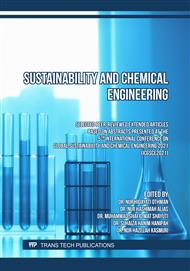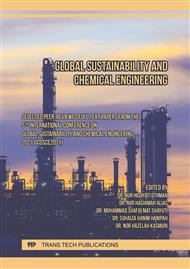[1]
G. Samin, D.B. Janssen, Transformation and biodegradation of 1,2,3-trichloropropane (TCP), Environ Sci Pollut Res Int, 19 (2012) 3067-3078.
DOI: 10.1007/s11356-012-0859-3
Google Scholar
[2]
I.A. Tan, A.L. Ahmad, B.H. Hameed, Adsorption isotherms, kinetics, thermodynamics and desorption studies of 2,4,6-trichlorophenol on oil palm empty fruit bunch-based activated carbon, J Hazard Mater, 164 (2009) 473-482.
DOI: 10.1016/j.jhazmat.2008.08.025
Google Scholar
[3]
A. Yazdanbakhsh, A. Eslami, G. Moussavi, M. Rafiee, A. Sheikhmohammadi, Photo-assisted degradation of 2, 4, 6-trichlorophenol by an advanced reduction process based on sulfite anion radical: Degradation, dechlorination and mineralization, Chemosphere, 191 (2018) 156-165.
DOI: 10.1016/j.chemosphere.2017.10.023
Google Scholar
[4]
M. Zhu, J. Lu, Y. Zhao, Z. Guo, Y. Hu, Y. Liu, C. Zhu, Photochemical reactions between superoxide ions and 2,4,6-trichlorophenol in atmospheric aqueous environments, Chemosphere, 279 (2021) 130537.
DOI: 10.1016/j.chemosphere.2021.130537
Google Scholar
[5]
A. Sheikhmohammadi, A. Yazdanbakhsh, G. Moussavi, A. Eslami, M. Rafiee, M. Sardar, M. Almasian, Degradation and COD removal of trichlorophenol from wastewater using sulfite anion radicals in a photochemical process combined with a biological reactor: Mechanisms, degradation pathway, optimization and energy consumption, Process Saf Environ Prot, 123 (2019) 263-271.
DOI: 10.1016/j.psep.2019.01.020
Google Scholar
[6]
J. Wang, Z. Sun, Successful application of municipal domestic wastewater as a co-substrate in 2,4,6-trichlorophenol degradation, Chemosphere, 280 (2021) 130707.
DOI: 10.1016/j.chemosphere.2021.130707
Google Scholar
[7]
J.E. Vuist, R. Linssen, R.M. Boom, M.A.I. Schutyser, Modelling ice growth and inclusion behaviour of sucrose and proteins during progressive freeze concentration, J. Food Eng., 303 (2021) 110592.
DOI: 10.1016/j.jfoodeng.2021.110592
Google Scholar
[8]
S. Samsuri, N.A. Amran, N. Yahya, M. Jusoh, Review on Progressive Freeze Concentration Designs, Chem Eng Commun, 203 (2015) 345-363.
DOI: 10.1080/00986445.2014.999050
Google Scholar
[9]
F.H. Ab. Hamid, N.A. Rahim, A. Johari, N. Ngadi, Z.Y. Zakaria, M. Jusoh, Desalination of seawater through progressive freeze concentration using a coil crystallizer, Water Sci Technol Water Supply, 15 (2015) 625-631.
DOI: 10.2166/ws.2015.019
Google Scholar
[10]
S. Moharramzadeh, S.K. Ong, J.E. Alleman, K.S. Cetin, Parametric study of the progressive freeze concentration for desalination, Desal, 510 (2021) 115077.
DOI: 10.1016/j.desal.2021.115077
Google Scholar
[11]
O. Miyawaki, C. Omote, T. Koyanagi, T. Sasaki, H. Take, A. Matsuda, K. Tadokoro, S. Miwa, S. Kitano, Progressive Freeze-concentration of Blueberry Juice and Its Application to Produce Blueberry Wine, in, (2017).
DOI: 10.11301/jsfe.16481
Google Scholar
[12]
J. Sánchez Machado, E. Hernandez, J. M Auleda, M. Raventós, Review: Freeze Concentration Technology Applied to Dairy Products, Food Sci Technol Int, 17 (2011) 5-13.
DOI: 10.1177/1082013210382479
Google Scholar
[13]
R. Fujioka, L.P. Wang, G. Dodbiba, T. Fujita, Application of progressive freeze-concentration for desalination, Desal, 319 (2013) 33-37.
DOI: 10.1016/j.desal.2013.04.005
Google Scholar
[14]
F.G.F. Qin, Z. Ding, K. Peng, J. Yuan, S. Huang, R. Jiang, Y. Shao, Freeze concentration of apple juice followed by centrifugation of ice packed bed, J. Food Eng., 291 (2021) 110270.
DOI: 10.1016/j.jfoodeng.2020.110270
Google Scholar
[15]
D. Krishnaiah, S.M. Anisuzzaman, A. Bono, R. Sarbatly, Adsorption of 2,4,6-trichlorophenol (TCP) onto activated carbon, J King Saud Univ Sci, (2013).
DOI: 10.1016/j.jksus.2012.10.001
Google Scholar
[16]
D. Suzuki, R. Shoji, Toxicological effects of chlorophenols to green algae observed at various pH and concentration of humic acid, J. Hazard. Mater., 400 (2020) 123079.
DOI: 10.1016/j.jhazmat.2020.123079
Google Scholar
[17]
N.Z. Safiei, N.N. Mohamed Nor, N. Ngadi, Z.Y. Zakaria, M. Jusoh, Progressive Freeze Concentration of Coconut Water: Effect of Coolant Temperature on Process Efficiency and Heat Transfer, Appl. Mech. Mater., (2014).
DOI: 10.4028/www.scientific.net/amm.695.447
Google Scholar
[18]
N.N.M. Zain, N.K. Abu Bakar, S. Mohamad, N.M. Saleh, Optimization of a greener method for removal phenol species by cloud point extraction and spectrophotometry, Spectrochimica Acta - Part A: Molecular and Biomolecular Spectroscopy, 118 (2014) 1121-1128.
DOI: 10.1016/j.saa.2013.09.129
Google Scholar
[19]
D.C. Montgomery, Design and analysis of experiments, John wiley & sons, (2017).
Google Scholar
[20]
S. Samsuri, M.M.M. Bakri, Optimization of fractional crystallization on crude biodiesel purification via response surface methodology, Sep. Sci. Technol., 53 (2018) 567-572.
DOI: 10.1080/01496395.2017.1392975
Google Scholar
[21]
N.A. Amran, M. Jusoh, Effect of coolant temperature and circulation flowrate on the performance of a vertical finned crystallizer, Procedia Eng, 148 (2016) 1408-1415.
DOI: 10.1016/j.proeng.2016.06.576
Google Scholar
[22]
O. Miyawaki, L. Liu, Y. Shirai, S. Sakashita, K. Kagitani, Tubular ice system for scale-up of progressive freeze-concentration, J Food Eng, (2005).
DOI: 10.1016/j.jfoodeng.2004.07.016
Google Scholar
[23]
F.H. Ab Hamid, S.N. Jami, Progressive Freeze Concentration for Wastewater Treatment from Food Industry, Key Eng. Mater., 797 (2019) 55-64.
DOI: 10.4028/www.scientific.net/kem.797.55
Google Scholar
[24]
B.R. Albuquerque, J. Pinela, L. Barros, M.B.P.P. Oliveira, I.C.F.R. Ferreira, Anthocyanin-rich extract of jabuticaba epicarp as a natural colorant: Optimization of heat- and ultrasound-assisted extractions and application in a bakery product, Food Chem., 316 (2020) 126364.
DOI: 10.1016/j.foodchem.2020.126364
Google Scholar
[25]
A. Rutherford, ANOVA and ANCOVA: a GLM approach, John Wiley & Sons, (2011).
Google Scholar
[26]
A.Y. Aydar, Utilization of response surface methodology in optimization of extraction of plant materials, in: Statistical Approaches With Emphasis on Design of Experiments Applied to Chemical Processes, IntechOpen, (2018).
DOI: 10.5772/intechopen.73690
Google Scholar
[27]
V.H. Rodrigues, M.R. de Melo, I. Portugal, C.M. Silva, Simulation and techno-economic optimization of the supercritical CO2 extraction of Eucalyptus globulus bark at industrial scale, Supercrit Fluids, (2019).
DOI: 10.1016/j.supflu.2018.11.025
Google Scholar
[28]
T. Aung, S.-J. Kim, J.-B. Eun, A hybrid RSM-ANN-GA approach on optimisation of extraction conditions for bioactive component-rich laver (Porphyra dentata) extract, Food Chem., 366 (2022) 130689.
DOI: 10.1016/j.foodchem.2021.130689
Google Scholar
[29]
T.K. Trinh, L.S. Kang, Response surface methodological approach to optimize the coagulation-flocculation process in drinking water treatment, Chem Eng Res Des, (2011).
DOI: 10.1016/j.cherd.2010.12.004
Google Scholar
[30]
A. Ciric, B. Krajnc, D. Heath, N. Ogrinc, Response surface methodology and artificial neural network approach for the optimization of ultrasound-assisted extraction of polyphenols from garlic, Food Chem. Toxicol., 135 (2020) 110976.
DOI: 10.1016/j.fct.2019.110976
Google Scholar
[31]
M.A. Bezerra, R.E. Santelli, E.P. Oliveira, L.S. Villar, L.A. Escaleira, Response surface methodology (RSM) as a tool for optimization in analytical chemistry, Talanta, 76 (2008) 965-977.
DOI: 10.1016/j.talanta.2008.05.019
Google Scholar
[32]
M. Jusoh, A. Johari, N. Ngadi, Z. Zakaria, Process Optimization of Effective Partition Constant in Progressive Freeze Concentration of Wastewater, Adv. Chem. Eng., 3 (2013) 286-293.
DOI: 10.4236/aces.2013.34036
Google Scholar
[33]
S. Okawa, T. Ito, A. Saito, Effect of Crystal Orientation on Freeze Concentration of Solutions, Int J Refrig, 32 (2009) 246-252.
DOI: 10.1016/j.ijrefrig.2008.06.001
Google Scholar



